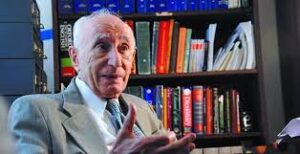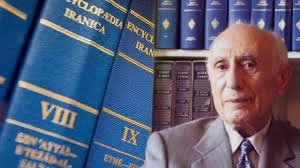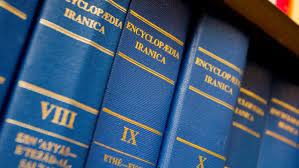Ehsan Yarshater

Ehsan Yarshater was a towering figure in the field of Iranian studies. His life was single-mindedly devoted to promoting a wider knowledge and a profound understanding of Iranian civilization. The scope of Professor Yarshater’s career was expansive, spanning teaching, research, publication, public engagement, philanthropy, and much more.
Born in Hamadan (Iran) on April 3, 1920, Professor Yarshater moved to Tehran at an early age and completed his secondary education there at the Tarbiyat School, graduating at the top of his class. This earned him scholarships to study at the Teacher’s College and the Faculty of Literature of the University of Tehran. After graduating in 1941 with the degree of Licence-ès-Lettres, he was employed by the Ministry of Education in 1942 as a teacher at Elmieh High School in Tehran. Two years later, he was appointed Deputy Director of the Preparatory Educational College (Danesh-sara-ye Moqaddamati) in Tehran. During these years, he also studied at the Faculty of Law and received a B.A. at the Legal Branch from that Faculty. At the same time, he pursued his study of Persian literature at the University of Tehran and received a doctorate in this field in 1947. His dissertation focused on15th-century Persian poetry.
A year later, he received a scholarship from the British Council to continue his studies in England, where he chose to study Old and Middle Iranian Languages with the noted German philologist W. B. Henning at the School of Oriental and African Studies of the University of London. He received an M.A. there in 1953 and returned to Iran the same year. He began to work on his British doctoral dissertation and received his second Ph.D. from SOAS University of London in 1960 by defending his dissertation on Southern Tati Dialects during the meeting of the Congress of Orientalists held in Moscow that year.
In 1953, he founded The [Royal] Institute for Translation and Publication (Bongah-e Tarjomeh va Nashr-e Ketab – BTNK), which went on to publish some 500 volumes before the Islamic Revolution of 1979. The titles ranged widely and covered many disciplines: they included the Persian text series; the Iranology series, comprising translations of major works of Iranologists into Persian; translations of world classics written for young people and children; and a series of books offering general knowledge in various fields. The BTNK was the most productive and culturally significant publishing venture in Iran and remained so as long as it operated.
Upon his return to Tehran in 1953, Dr. Yarshater was appointed first as an Assistant Professor of Persian Literature and, in the following year, of Old Persian at the University of Tehran. In 1958, he was invited by Columbia University to be a Visiting Associate Professor of Indo-Iranian for two consecutive years. In 1960, he succeeded Professor Ebrahim Pourdavoud as Professor of Ancient Iranian Culture at the University of Tehran. In 1961, Columbia University offered him a permanent position, the newly founded Chair of Iranian Studies endowed by Hagop Kevorkian, a well-known Armenian art collector. Having accepted the offer, he moved back to New York with his wife, Latifeh Alvieh (1926-1999), whom he had met in 1956 and married in 1960.
A graduate of the American School for Girls in Tehran, Latifeh Alvieh Yarshater held a B.A. and M.A. in Middle Eastern Studies from Columbia University. From 1951 through 1961 she served as Cultural Advisor to the United States Information Agency in Tehran in its leader grant program. Once settled in New York, she continued to offer her expertise to several councils and committees, including the National Council of Women of the United States. From 1986 to 1990, she worked at the Middle East Institute of Columbia University as Coordinator of its Outreach Program, designed to provide a more informed understanding of Middle Eastern affairs to students and teachers, as well as to the general public.
From 1964 to 1966, Professor Yarshater was granted extended leave from Columbia University. During this period, which he spent in Iran, beside other occupations, he conducted intensive fieldwork and recorded many hitherto understudied village dialects of Iran. His scholarly meticulousness and analytical skill, and the attention to detail in both phonology and morphology, made his work stand out as an exceptional contribution in Iranian dialectology.[1]
The most outstanding feature of Professor Yarshater’s many lifelong achievements was his dedication to the founding of cultural institutions and the unwavering determination with which he attended to their progress. In 1968, he founded the Center for Iranian Studies at Columbia University, the foremost academic research center in Iranian Studies in the United States. Dedicated to the study of Persian history and culture, the Center’s extensive program of scholarly publications, seminars, and varied and ambitiously long-term projects put on full display Professor Yarshater’s organizational skills, perseverance, and ability to reach out to scholars worldwide, leaving a remarkable imprint.
Professor Yarshater was the Founding Editor of the Encyclopædia Iranica, arguably the world’s most extensive scholarly, groundbreaking, and comprehensive reference work on Iranian civilization in its widest sense, authored by numerous scholars. It is dedicated to the broad and inclusive study of all aspects of Iranian civilization in the Middle East, the Caucasus, Central Asia, and the Indian subcontinent, offering a comprehensive and detailed overview of topics from different perspectives.
In 1979, the Encyclopædia Iranica project at Columbia University won an initial grant from the National Endowment for the Humanities (NEH) for $17,500. Over the next four decades, the Encyclopædia Iranica received $6.25 million in NEH support. The first fascicle of the Encyclopædia’s printed edition appeared in 1982 and the first volume in 1985, while the first version of the web-based digital edition was established in 1996. Today, the project numbers fifteen printed volumes and more than seven thousand online articles with contributions from more than 1,600 scholars who are experts in their fields. “Projects like the Encyclopædia Iranica bring together the best scholars in their field to create new knowledge and help us better understand our world,” said NEH Chairman Jon Parrish Peede. “Without the vision of scholars like Dr. Yarshater, our knowledge of the Middle East would be poorer.”
Professor Yarshater was also the Founding Editor of A History of Persian Literature. This 20-volume, authoritative survey is designed to reflect the status and significance of Persian literature as the single most important accomplishment of the Iranian people through its long history. It includes extensive and carefully selected specimens of poetry and prose with translations and commentary by prominent scholars.
Professor Yarshater was also the author or editor of a number of other highly acclaimed scholarly works. He served as the Founding General Editor of the Persian Text Series, the Persian Heritage Series, the Persian Studies Series, the Modern Persian Literature Series, and the Persian Art Series, among others. He was also the General Editor of The History of Beyhaqi (3 vols.). The annotated translation of Tabari’s History in 40 volumes was completed under his General Editorship.
Among his books are Persian Poetry in the Second Half of the 15th Century (in Persian, 1953), and Southern Tati Dialects (1970). He edited the third volume of The Cambridge History of Iran, in two parts, covering the Seleucid, Parthian and Sasanian periods (1983, 1986), to which he contributed his magisterial “Iranian National History” and Persian Literature (1988). His frequently cited and erudite chapter, “The Persian Presence in the Islamic World” is included in a volume with the same title as part of the Thirteenth Giorgio Levi Della Vida Biennial Conference in his honor (1998).
He was an honorary member of Societas Iranologica Europaea and of the Association for Iranian Studies, for which he served as President as well. He was also a life member of the American Institute of Iranian Studies
Lecture series in his name have been instituted at the University of London (in Persian Art and Culture, 1993; in Persian Literature, 2016), the University of California at Los Angeles (1992), the University of Paris (2000), the University of Maryland (2005), and existed, up to 2005, at Harvard University, and at Yale University (2014).
Significantly, Professor Yarshater’s career also involved philanthropy and charitable foundations. In 1983, he established the Persian Heritage Foundation, originally called the Yarshater Fund, and, in 1990, he founded the Encyclopaedia Iranica Foundation. He was able to obtain uninterrupted funding for the Center for Iranian Studies and its projects through these Foundations, by successfully lobbying individual donors, by obtaining grants from the NEH and other agencies, and by contributing art and rare books for sale from his personal collection. In 2009, with the economy down and funding becoming scarce, he donated the proceeds from a prized Rodin sculpture to the Persian Heritage Foundation to help finance the History of Persian Literature series and other projects. “The 34-inch-high sculpture has a lovely patina and is what Christie’s described as an ‘extremely rare bronze cast, known as the Milwaukee version, one of only five created during the artist’s lifetime from the plaster model of the classic sculpture.’ The auction house catalogue estimated it would bring $1.5–$2 million. Yarshater was working on the encyclopaedia in his office when a Christie’s representative called with news of the final hammer price: $6,354,500.” “Within a matter of weeks, the money was fed into our account, and our editors and other staff could be paid. Rodin came to our rescue,” Yarshater said in an interview published in Columbia College Today, Fall 2012.
In 2006, he established the Persian Heritage Foundation Fellowship Fund at Harvard University. In 2012, he established the Ehsan Yarshater Fellowship Fund at the Graduate School of Arts and Sciences at Columbia University and in 2014 the Ehsan Yarshater Persian Heritage Fund at Yale University.
Professor Yarshater was celebrated and was the recipient of several awards including the Giorgio Levi Della Vida Medal of The Gustave E. von Grunebaum Center for Near Eastern Studies at the University of California at Los Angeles (1991); Spirit of Iranian Noted Achievers (SINA, 2013); Ellis Island Medal of Honor (2015); Bita Prize for Persian Art (2015), and many more. But he never seemed to care much about the accolades; to Professor Yarshater, they were almost a distraction from work. The only reward he really seemed to prize was the success of the acclaimed Encyclopædia Iranica.
Professor Yarshater was an editor with a special kind of genius, combining contrary qualities in one mind: assertive and self-effacing, commanding and sensitive, infinitely curious and sharply focused, patient and fearfully demanding. One of his much-remarked gifts was his innate ability to spot the kind of unexplored topic that had hitherto escaped the notice of scholars and reference works. He combined the intellectual excitement of a brilliant graduate student, with the authority and ease of someone who had been at the center of the academic world for more than half a century.
On August 15, 2018, Columbia University received a $10 million gift from the Persian Heritage Foundation to endow and rename the Center for Iranian Studies in his honor. The official announcement of the establishment of the Ehsan Yarshater Center for Iranian Studies came just weeks before his passing on September 2, 2018. On receiving this news, Professor Yarshater remarked “Having devoted my entire life to the preservation and advancement of Persianate culture, I am thankful that through the establishment of this Center, my life’s work will continue unabated.”
Publications by Dr. Yarshater


Books and Edited Volumes
- Theorems and Remarks* (al-Ishārāt wa’l-tanbīhāt) by Avicenna, tr. into Persian in the 13th century; annotated edition, Tehran: National Monuments Society, 1953.
- Five Treaties in Arabic and Persian (Panj Resāla) by Ebn Sinā, annotated edition, Tehran: National Monuments Society, 1953.
- Persian Poetry under Shahrokh: The Second Half of the 15th Century (Sheʿr-e fārsi dar ʿahd-e Shāhrokh), Tehran: The Tehran University Press, 1955.
- Legends of the Epic of Kings (Dāstānhā-ye Shāhnāma), Tehran: Iran-American Joint Fund Publications, 1957, 1958, 1964; 2nd ed. 1974, 1982 (awarded a UNESCO prize in 1959).
- Old Iranian Myths and Legends (Dāstānhā-ye Irān-e bāstān), Tehran: Iran-American Joint Fund Publications, 1957, 1958, 1964 (Royal Award for the best book of the year, 1959).
- With W.B. Henning (eds.), A Locust’s Leg: Studies in Honour of S.H. Taqizadeh, London: Percy Lund, Humphries & Co., 1962.
- Modern Painting (Naqqāshi-e novin). 2 vols., Tehran: Amir Kabir, 1965-66; 2nd printing, 1975.
- A Grammar of Southern Tati Dialects, Median Dialect Studies I, The Hague and Paris: Mouton and Co., 1969.
- Iran Faces the Seventies (ed.), New York: Praeger Publishers, 1971.
- With D. Bishop (eds.), Biruni Symposium, New York: Center for Iranian Studies, Columbia University, 1976.
- Selected Stories from the Shahnāma (Bargozida-ye dāstānhā-ye Shahnāma), Vol. I. Tehran: BTNK, 1974; reprint, Washington, D.C.: Iranian Cultural Foundation, 1982.
- With David Bivar (eds.), Inscriptions of Eastern Māzandarān, Corpus Inscriptionem Iranicarum, London: Lund and Humphries, 1978.
- With Richard Ettinghausen (eds.), Highlights of Persian Art, New York: Bibliotheca Persica, 1982.
- Sadeq Hedayat: An Anthology (ed.), New York: Bibliotheca Persica, 1979.
- Cambridge History of Iran, Vol. III: Seleucid, Parthian and Sassanian Periods (ed.), Cambridge: Cambridge University Press, 1982.|
- Persian Literature (ed.), New York: State University of New York Press, 1988.
- Persian Lyric Poetry in the Classical Era, 800-1500: Ghazals, Panegyrics and Quatrains (ed.), A History of Persian Literature, vol. II, London and New York: I.B. Tauris & Co Ltd., 2019.
Read more on source:
1




